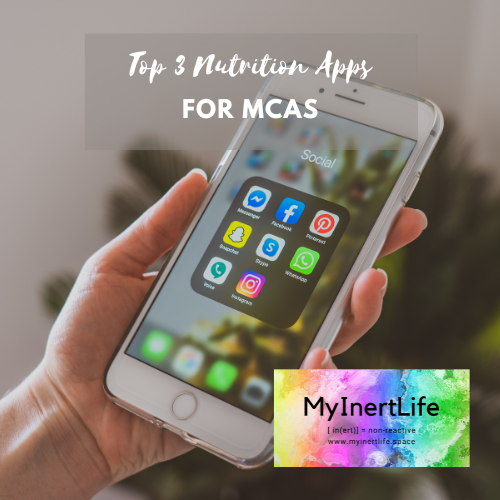

apps for MCAS
This post lists my top 3 most useful nutrition apps for MCAS. When you constantly need reliable information on carbs, histamine, oxalates, and salicylates it is key to have the right apps on your phone (and desktop!)
As an Amazon Associate, I earn from qualifying purchases.
As an Amazon Associate, I earn from qualifying purchases.
Mast Cell Activation Syndrome (MCAS) is a chronic condition that affects all organ systems. MCAS is serious and disabling and people with MCAS experience often significant and debilitating symptoms daily, including anaphylaxis, which can be fatal.
MCAS is often found in combination with other chronic conditions such as Ehlers-Danlos Syndrome (EDS) and Postural Orthostatic Tachycardia Syndrome (POTS).
Frequently healthcare providers do not know about MCAS, and the tests for MCAS are problematic because they are not uniformly reliable. MCAS can be difficult to manage. Treatments include blocking mast cell mediators with anti-histamines and mast cell stabilizers, as well as avoiding triggers.
Check out this post on how to manage MCAS.
The bucket theory offers a helpful analogy for understanding symptom reactions with MCAS.
Think of your body as an empty bucket that you want to keep from overflowing. Different foods and activities fill your histamine bucket at different speeds but they combine to form the total level of histamine in your body (how full your bucket is). A fuller bucket means you have more histamine symptoms. When you manage triggers, reduce exposure to known triggers, and take medications and supplements to reduce histamine, you can manage the level of your bucket.
In my experience, a significant part of dealing with MCAS is being a detective. I track my symptoms on my symptom log against the new foods I try, and my environmental exposures on a daily basis to determine what might be causing my symptom flaring.
With the top 3 most useful nutrition apps listed in this post, you will save time and energy gathering the information you need on foods.
For tracking daily carbohydrate intake I love Carb Manager. It is well worth it to get the paid version for the functionality it offers. I especially like an app that I can use on my desktop as well as my phone, and this one fits the bill. And it is a key tool for recipe development. You can add your own foods and develop your own recipes, tweak them to get them within your desired carb macro and save/print out recipes in .pdf form.
The Food Intolerances app is a great app that in the paid version (around $15) gives you readouts for many foods on histamine and salicylates. I’m sad that it doesn’t also track oxalates, but it is still a nice app. You enter your dietary intolerances and the app applies those criteria to all of the foods in its database. You get a quick and easy read on foods with the red/yellow/green color coding (green is good, obvi).
If you are like me you are constantly referencing lists of foods high or low in oxalates. This Oxalate calculator is not an app, but an online calculator that is helpful because it lists more foods than most of the lists I’ve found online. It also has three settings so that you can customize the reading based on the health of your gut.
Knowing your symptom progression in a symptom flare is the key to developing your own rescue plan. In this post, I discuss how to determine your own symptom progression. Once you know what typically happens in your symptom progression you can design a rescue plan to address those symptoms.
Want a tool to easily keep track of your symptoms? Sign up for my newsletter and you will receive my free 50-page ebook of lower-histamine, grain-free, sugar-free, Keto recipes, my free symptom log, and a free two-week meal plan!
The Safe and Sound Protocol (SSP) is a listening therapy based on Polyvagal Theory created by Stephen Porges to unlock your ability to think, feel, and connect better through nervous system regulation. You use the SSP via an app on your phone and listen with over-the-ear headphones to specially filtered music that heals the nervous system, specifically the vagus nerve. You subscribe to the app with a provider like me and listen to the specially curated music for 30 minutes each day for a 5-hour cycle. Studies show the SSP has a profound effect on mental health and chronic conditions
You can sign up for the SSP here!
Rocks and Roots chronicles my journey solo backpacking the Superior Hiking Trail and overcoming nervous system dysregulation, gut dysbiosis, and Mast Cell Activation Syndrome symptoms to hike 328 miles successfully.
Healy is an individualized microcurrent device I use to reduce inflammation. Check out this post for more about Healy.
I provide one-on-one in-person and remote chronic illness and caregiver coaching and Sacred Self-Healing Sessions based on the Sacred Self-Healing Method, a proven novel co-creative healing modality detailed in my Books.
Click here for more information.
I’d love to have your reply below!
The preceding material does not constitute medical advice. This information is for information purposes only and is not intended to be a substitute for professional medical advice, diagnosis, cure or treatment. Always seek advice from your medical doctor.
Did you know that Betsy offers chronic illness support coaching? This post discusses the benefits…
This post discusses the topic of what is the best nervous system retraining program. What…
This post discusses using binders for toxins when you have MCAS. Toxins are one of…
This post discussed a technique called the SSP thirty-second reset, which stops my MCAS symptoms…
This post is about the difference between dysautonomic temperature dysregulation and flushing. I experience temperature…
This post discusses why mycotoxins are triggering your MCAS, and what to do if they…
This website uses cookies.
View Comments